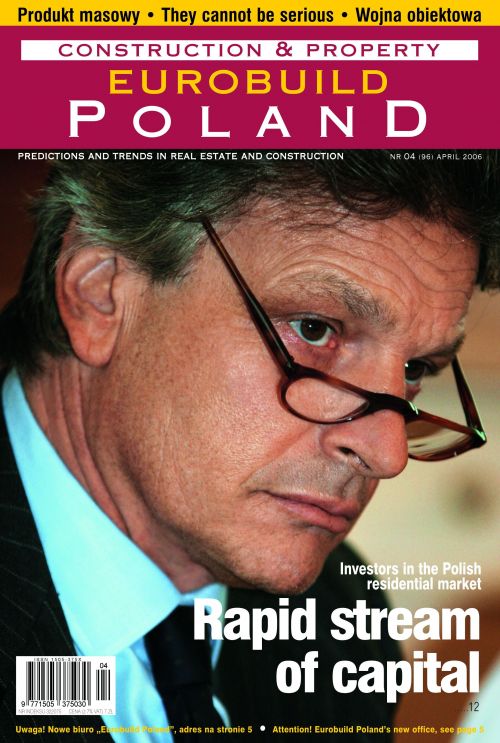On the slide
The slump in the yields of office, retail and warehouse investments in 2005 was evident not only in the Polish market. A similar trend was visible throughout most Central European countries, as well as in the \'old\' European Union 15 and looks set to continue this year
Falling yields and other market phenomena were highlighted by the authors of CB Richard Ellis\' "European Investment" report, which was released to the public at the MIPIM real estate trade fair in Cannes. It is devoted, first and foremost, to a summary of 2005, but also includes a forecast for the next few months.
Huge appetite
The fall in yields was brought about by a high demand for the prime properties in the best locations, together with their increasing shortage of supply. The effect was seen in the interest expressed by investors in smaller cities, as well as being corroborated by a thorough analysis of the possibility of investing in the housing and hotel market, in mixed-use projects, and also in the so-called emerging markets in the eastern part of Europe.
Though the declining trend in yields was first noticed in 2004 and had been forecast for 2005, the degree to which it occurred in Central Europe came as a surprise to most analysts. The CB Richard Ellis report claims that the average yield from the best office and retail properties amounted to app. 7 and 7.5 pct late last year in this region, and for warehouse properties from 8 pct in Prague to 15 pct in Moscow. Office and retail properties were purchased in the EU-15 countries with yields around 5.25 pct and at slightly below 7.5 pct for warehouse-industrial properties.
Cory Hrncirik, head of CB Richard Ellis East and Central Europe Research Department remarks that: "In the next few months we will surely see deals in which yields approach Western European rates." Hrncirik thinks that the greatest opportunity to level out yields exist when selling the prime office buildings. His view seems to be confirmed by the purchase of the Warsaw Metropolitan office building, which according to information received by Eurobuild suggests the yield in this transaction is substantially below 6 pct.
Back to hotels and mixed-use projects
Forty five percent of the EUR 141.7 bln worth of all investment transactions in Western Europe were for office properties. Precisely the same percentage was noted in Central and Eastern European markets, with the value of all investments in 2005 in this part of Europe amounting to much less - in fact a mere EUR 5.8 bln.
Investments in retail properties came second, amounting to 27 pct in the West and 41 pct in Central and East Europe, with the interest in this type of investment being greater than in 2004.
Eight percent of the value of all contracts signed in the EU-15 were for warehouse and industrial properties, compared to around 6 pct in the emerging markets, the majority of which took place in Poland, the Czech Republic and Hungary. There would surely have been many more transactions were it not for the lack of buildings for sale.
The remaining 2 sectors, hotel and mixed-use, are becoming more interesting for investors with each passing year, which is evidenced in the rising value of such transactions. These amounted to 20 pct of the total value of all transactions in the EU-15 and to around 11 pct in Eastern and Central Europe. All the pointers suggest that this trend will continue in 2006 as well.
Irish on the attack
Who is buying and selling properties? Institutional and private investors who have consolidated their position in Western Europe are interested in purchases first and foremost, with real estate companies, e.g. developers leading the field among sellers.
Americans bought the most in the EU-15 last year, all of EUR 13 bln. USA investors over the same period sold real estate for a value of EUR 8 bln. The Irish came second with around EUR 7 bln, but sold a much smaller value of assets (EUR 1.8 bln) thereby retaining their number one position in the ranking of investors. German investors also stayed in a strong position, with a net amount of more than EUR 4 bln (15.8 bln gross). The British, Norwegians and Dutch were also actively purchasing real estate. Cory Hrncirik of CB Richard Ellis stated that: "Those investors will continue to be very active, which does not necessarily mean changes in the general ranking list. New players from outside Europe, for instance investors from Australia and the Near East will become market players in 2006 and could change the shape of the list."
Deals concluded by foreign investors accounted for 89 pct of the total value (EUR 5.162 bln) of all investments in East and Central Europe. German investors topped the group (EUR 1.26 bln), followed by the Austrians (EUR 1.044 bln). Americans took third place with EUR 638 mln followed by the Irish (EUR 522 mln). Czech and Polish investors accounted for 10 pct of the market value last year with EUR 580 mln. Cory Hrncirik thinks German and Austrian investors will continue to lead on East and Central Europe investment markets for the next several years. He informs us, however that: "A rise in the activity of local investors should also occur, since they will be playing \\\'first fiddle\\\' on more mature markets. They know the local market better and have skilled personnel on the spot able to take decisions more rapidly, and also have the advantage that operating costs are usually lower."
The German factor
Despite several worrying signals, the analysts from CB Richard Ellis are of the opinion that the European investment market should grow this year at an equally rapid pace. A number of investors have earmarked considerable sums to purchase real estate, and this will have to be spent. Fund managers are frequently unable to find properties of an adequate standard, even though they have sufficient money to buy, which means they will have to find other product vehicles.
Such a prognosis sounds good to landlords, but is offset by data showing costs are rising to win capital. The effects of that were visible in several tenders where investors were forced to revise the value of their offers. Even so, the profits available on the property market are still greater than lending costs, which means the latter would have to climb significantly were they to be felt on the market to any tangible degree.
The authors of the European Investment report are of the opinion that a more definite impact on the investment market throughout Europe would be felt were investors in German open-ended investment funds to move away from them (more than EUR 7 bln were taken out of these funds in December and January alone). These funds will have to get rid of a certain number of properties if they are to regain financial liquidity. But it does seem that the high demand for real estate will be able to absorb the additional supply.
Magda Konstantynowicz






















































